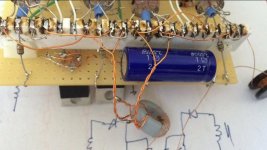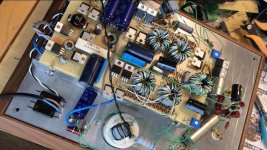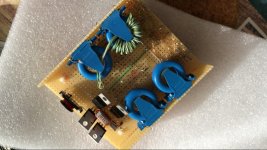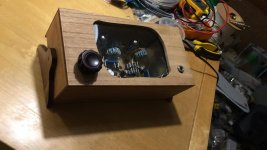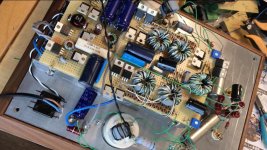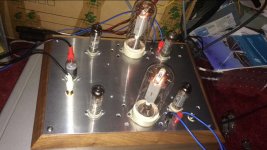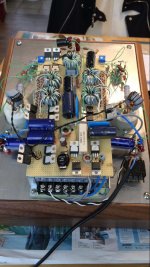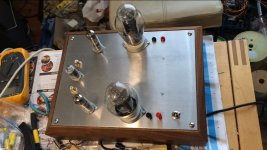We know residual B+ hum tends to cancel in PP stages, the same going for the heater supplies - higher PSRR for PP. Can we get away with AC then? What about IMD?
Yes, that is a concern, as everything it is a compromise between several evils. I will check this as there are multiple threads about this topic.
It kinda depends on how skilled you are, DC escpecially current sources are very quiet and easy to implement. Some seem to prefer AC some DC.
speaker efficiency is also a concern. a 103dB horn is going to produce a louder hum signal than a 93dB shelf speaker.
If you want to cancel the hum from the filament, its possible but both filaments need to be in phase.
If your building on a separate power supply chassis i would go with DC for the simple reason you can send over relatively clean DC through your umbilical cord.
a LM317 is more than adequate to get low hum.
speaker efficiency is also a concern. a 103dB horn is going to produce a louder hum signal than a 93dB shelf speaker.
If you want to cancel the hum from the filament, its possible but both filaments need to be in phase.
If your building on a separate power supply chassis i would go with DC for the simple reason you can send over relatively clean DC through your umbilical cord.
a LM317 is more than adequate to get low hum.
Just saw a measurement comparison by diyaudio member @euro21. Yes, it's worth to use DC even in PP stages, as there is resulting IMD. 😱
That begs the question, I dont like pure current sources myself because they take too long to get the cathode to temperature. and if you use a common 317 as a voltage regulator it is going to affect the sound. If you use a modern LDO you need a output cap to maintain stability so your gonna be stuck with a cap across the fillaments.
Now im impressed, could you please share the schematic? Il try to to give some constructive criticism.
http://davidberning.com/images/microZOTL/microZOTL_Manual.pdf
I made some adjustments and simplifications but in general it is the same.
I made some adjustments and simplifications but in general it is the same.
Attachments
Last edited:
When using DC, soundwize I find it the most important to smooth using a choke input filter, as this limits the harmonically rich pulses.
My head is spinning from looking at that schematic on my phone, would i be correct in assumeing that these are self oscillating Colprits? oscillators?
It also increases weight, I mostly just stuff the PSU on a different chassis.
if you use a full wave (center tapped transformer) for your heater you can do away with two diodes.. and the copper resistance is larger so you decrease the pulses somewhat.
if you use a full wave (center tapped transformer) for your heater you can do away with two diodes.. and the copper resistance is larger so you decrease the pulses somewhat.
Yes,something like that. It is more like a Royer oscillator.
Like the ZVS circuit used for induction heating right?
It is just to generate a the signal needed to feed the LCC resonator.
Attachments
Last edited:
Lampie519, I have seen some of your projects here and on other forums in the past and what you do is still straight up arcane wizardry to me.
I use 250Khz AC for my heaters.
That's an interesting idea. Wondered if you do scale it up and do it for say a pair of 300B. Separate windings for each valve with a CT for the cathode to ground.
Yes i idid.
Attachments
Last edited:
@Gideon
I think it has to do with truely grasping an idea (not nessecary the math behind it but the intension) and simplify it first. In may cases it becomes clear and then you can start fitting more and more until it becomes complex but it is actually not. Most hobbyists want to start with something "Grand" like a 100 W OTL amp with 6 Power tubes per channel or difficult tubes like 6C33 etc. (i was no different). I see many people on this forum just waiting until they get ALL the answers before starting a new project. Just start and don't wait is my advise. Making mistakes is part of learning and not just follow someones idea. Yes, many here will try to help but the amount of info can be overwhelming and even be contra productive as there are 1000 ways to approach an issue and everyone of us has a "better" solution then the other ( i am no different in that respect). Studying circuits is great but smelling burning resistors is"enlightening"
I think it has to do with truely grasping an idea (not nessecary the math behind it but the intension) and simplify it first. In may cases it becomes clear and then you can start fitting more and more until it becomes complex but it is actually not. Most hobbyists want to start with something "Grand" like a 100 W OTL amp with 6 Power tubes per channel or difficult tubes like 6C33 etc. (i was no different). I see many people on this forum just waiting until they get ALL the answers before starting a new project. Just start and don't wait is my advise. Making mistakes is part of learning and not just follow someones idea. Yes, many here will try to help but the amount of info can be overwhelming and even be contra productive as there are 1000 ways to approach an issue and everyone of us has a "better" solution then the other ( i am no different in that respect). Studying circuits is great but smelling burning resistors is"enlightening"
- Home
- Amplifiers
- Tubes / Valves
- PP DHT output stage, is DC heater necessary?
